Tweeks for Geeks 2022 by Greg Simmons
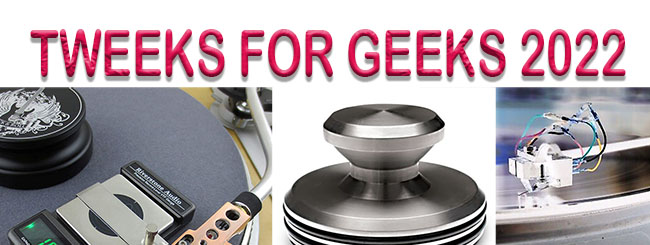
 Great Stuff You Might Need
Great Stuff You Might Need
Apparently, it has been almost two years since I wrote one of these Tweaks for Geeks columns. Despite the crushing boredom of the pandemic and quarantine, and a steady stream of widgets, doodads, and thingy-ma-dos floating through my listening room, I just forgot to write it. Better late than never, I suppose. This collection comprises vinyl accessories or services, a category with an unlimited variety of functions and prices. Offended as I am by stupidly expensive accouterments, this group stays within a reasonable price-to-value ratio, and all of these items represent excellent bang for the buck.
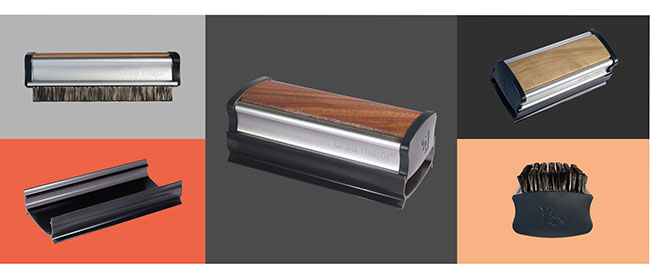
The Ursa Major Record Brush
 Ursa Major is the great bear constellation in the northern sky, an assemblage of stars that includes the Big Dipper as the hips and tail of the great galactic Grizzly. Ursa Major is also the name of one of the better record brushes I’ve had the pleasure of using.
Ursa Major is the great bear constellation in the northern sky, an assemblage of stars that includes the Big Dipper as the hips and tail of the great galactic Grizzly. Ursa Major is also the name of one of the better record brushes I’ve had the pleasure of using.
Ursa Major, which is based in Germany, offers a relatively heavy brush made of aluminum with a genuine wood insert that is available in a variety of species. I chose olive wood because it matches the handles of my beloved Sabatier carbon steel chef’s knives. The brush also comes with an extruded aluminum base that keeps it from resting on its bristles when set down. The edge of the base doubles as something to swipe the dust off the bristles. Speaking of those bristles, there are seven thick rows of them. It would be a great (and likely short) story if owners Christine Pretorius and Jim Carter chose the name because they personally wrestle a bear to obtain fur for those seven rows, but alas, the bristles are made of soft carbon fiber. The current price, direct from the factory, is $52 (U.S.). In today’s world of idiotic analog accessory pricing ($895 record clamp, anyone?) struck me as quite reasonable for the build quality of the product.
But does it work any better than the twenty-dollar, two-row folding brush that’s so ubiquitous in the analog world? In a word, definitely. The seven rows of bristles offer dust little quarter, collecting and removing more of it than any other brush I’ve used. Whether you roll it up after a few rotations or simply angle it off to the side like a snowplow (my preferred technique), the Ursa Major leaves almost nothing behind. Less dust equals quieter records, fewer pops and ticks, and an overall improved listening experience. The Ursa Major record brush is a terrific analog accessory with a high-quality look and feel, reasonably priced, and very effective at sweeping vinyl.
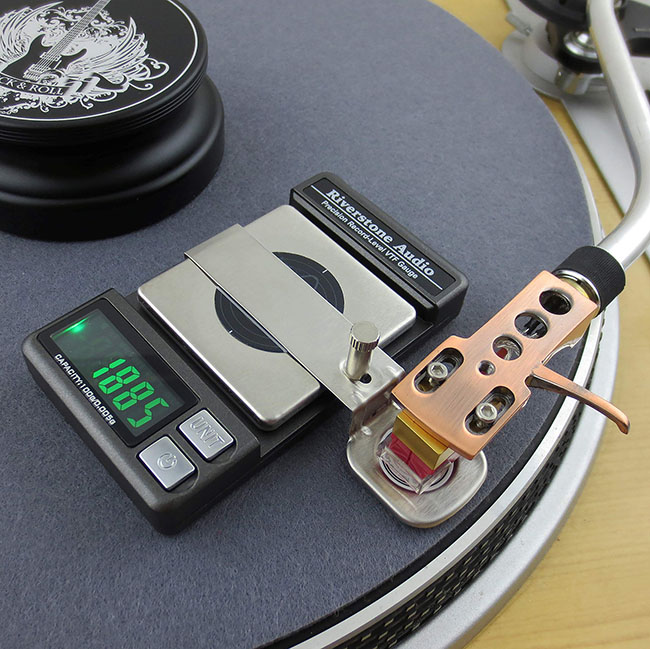
The Riverstone Audio Record-Level Turntable Stylus Vertical Tracking Force Gauge
That’s a mouthful. When you’re ready to step up from the $12 VTF gauge that many people buy off eBay (The same gauge Pro-Ject shamelessly stamps their logo on and sells for $50), the Riverstone Audio VTF scale would be an excellent option. At a whopping $32, it is a stone-cold bargain.

Setup and use are straightforward. Simply attach the arm with the dot pad onto the scale itself, let the scale settle to zero, then lower the stylus onto the gun-sight hash mark. In the case of my Lyra Delos, getting the exact factory-recommended VTF of 1.75g still requires a good deal of minute adjustment to the counterweight. Still, the Riverstone scale offers just a little more confidence that I’m actually getting the weight I want. The Riverstone Audio VTF gauge is the kind of analog accessory I can always get behind: It’s accurate, easy to use, and it would be a bargain at three times the price. Well done.
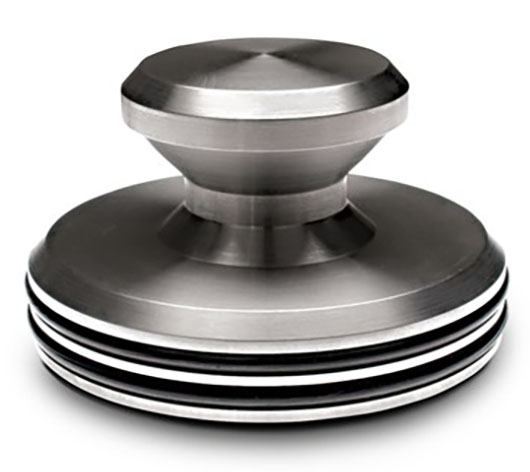 VPI HRX Record Weight
VPI HRX Record Weight
SOTA turntables have – almost since their inception – offered some contraption to fit over the spindle, whether weighted or not. Early vacuum versions had a little rubber cap that acted as a suction cup to help sustain the negative air pressure that kept the record welded to the platter. Later came the I-Clamp and the significantly heavier Reflex Clamp, and I’ve used all three on my 1987 Star Sapphire, particularly the Reflex Clamp. When attached properly, it did a good job, audibly tightening the bass, but getting it to clamp properly could be a bit of a trick. You couldn’t just drop it on the spindle and flip the lever. Doing so left daylight between the label and the clamp, defeating the whole point of using it in the first place. Getting a tight seal required putting some pressure on the table’s suspension, then flipping the lever to lock it in place. Over time the repeated pressure on the suspension started to deform the springs. After a few years of this, the platter was riding low. Worse, the platter/arm board assembly needed to be re-leveled almost weekly. I’ve owned this table for fifteen years, and I still love it, but after its last trip to the factory where it received – among other things – new springs, I decided it was time to try something else.
The VPI HRX Center Clamp is not a new product – it’s been around for well over a decade, surviving the HRX turntable it was originally designed for. It’s also not a clamp; it’s a weight. As these things go, it is relatively heavy, at 760g (1.6 lbs). It costs $170. The HRX weight is lathed from solid stainless steel and has two rubber O-rings stretched around its widest part. There is no felt or padding where it makes contact with the record label, just plain stainless steel. Its spindle hole is not threaded.
To use it, simply place it over the platter spindle, and you’re off to the races. It equals the Reflex Clamp in its ability to hold the vinyl tightly to the platter but without having to mash down the suspension every time I use it. In fact, carefully placing the weight on the platter barely depresses the springs at all.
Now someone might be thinking that adding a pound-and-a-half directly over the spindle might create unwarranted wear and tear on the bearing assembly, but my turntable has the current version of SOTA’s wonderful Mag-Lev bearing, so there’s no ball bearing point at all, and the weight is certainly not bottoming out the rest of the assembly if you’re concerned about the additional weight on your bearing consult with your turntable’s manufacturer.
Sonically it makes the same improvement as the Reflex Clamp: it tightens up the bass appreciably and gives the entire frequency spectrum a little better definition and clarity. In addition to my SOTA, I’ve also used this weight on non-suspected tables with similar positive effects. The VPI HRX Center Weight is simple to use, makes an audible sonic improvement, particularly in the bass, and while it’s not bargain-basement inexpensive, it is still a good deal.
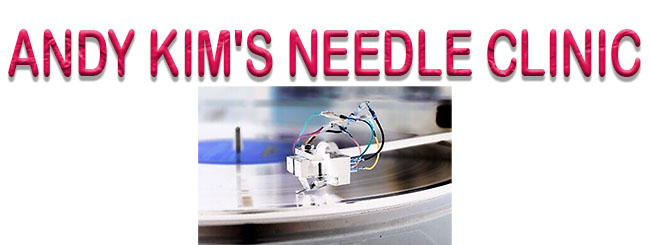
Andy Kim’s Needle Clinic
 My reference cartridge is a Lyra Delos, which recently seemed to be getting a little long in the tooth. Lord knows how many sides it had under it in its four years of play, and it just didn’t sound all that good anymore. Plus, after Mikey Fremer’s warning about the potential dangers of the Onzow ZeroDust and other gel type stylus cleaners leaving a gooey residue on the tips – which I had been using and recommending, to my regret – I was able to verify that there was indeed some gunk on the stylus that I couldn’t get off with the stylus cleaners I had at hand. It seemed like a good time to have some work done.
My reference cartridge is a Lyra Delos, which recently seemed to be getting a little long in the tooth. Lord knows how many sides it had under it in its four years of play, and it just didn’t sound all that good anymore. Plus, after Mikey Fremer’s warning about the potential dangers of the Onzow ZeroDust and other gel type stylus cleaners leaving a gooey residue on the tips – which I had been using and recommending, to my regret – I was able to verify that there was indeed some gunk on the stylus that I couldn’t get off with the stylus cleaners I had at hand. It seemed like a good time to have some work done.
Without going into too many details, when I bought my brand new U.S. market Delos, I paid less than half its total retail price (one of the occasional perks of reviewing equipment). Sending the cartridge back to the factory for the work would have cost more than I paid for it in the first place. Frankly, for that much bread, it would almost make more sense to make up the difference and just buy a new cartridge, whether another Delos or something in a similar price range. The economics of the factory tune-up just didn’t work.
One of my h-fi buddies had his cartridge re-tipped by Andy Kim’s Needle Clinic and was pleased with the results. His experience was that the service was not terribly expensive, the turnaround was quick, and he insisted that the sound quality of the returned unit exceeded his expectations. I did some additional checking in the usual forums and found plenty of similarly positive reviews.
Andy does indeed respond quickly to inquiries – within an hour or so, as a matter of fact. He also assured me that he does all his own work and that he could generally turn a cartridge around in a single day(!). For my cartridge, he would install a new micro-ridge nude stylus on a boron cantilever, matching –at least approximately – the factory original—the price: $450. In my circumstance, that seemed far more reasonable than the factory job, so I FedExed my cartridge off to California. True to his word, Andy did indeed turn the cartridge around in a single day and – except for the four nail-biting days when the U.S. Postal Service lost the package (I hate those guys) – it came back safe and sound.
After I reinstalled the Delos on the Audio Creative GrooveMaster III tonearm and SOTA Star-Sapphire turntable, another friend came over with a multimeter and – using the Analogue Productions Ultimate Test LP – performed an azimuth test with the front face of the headshell set dead-parallel to the record. The difference in channel balance was a mere 0.003, suggesting Mr. Kim pays close attention to ensuring that the stylus is as close as possible to a ninety-degree angle to the flat plane of the cartridge’s mounting surface. Given the pervasive complaints people make about how far out-of-whack their brand-new cartridges can be straight from the factory, this was encouraging.
Physically, the only visual differences between the stock Delos and the re-tipped version are that the cantilever is now silver instead of gold, and the tiny bit of white fabric that originally covered the motor unit is now a bit of cellophane tape.
Spinning some records, the first thing I noticed is that this re-tipped Delos is significantly quieter in the groove, not just quieter than the worn cartridge I had sent off, but quieter than the same cartridge when it was brand new out of the box. This surprised me, as the Delos was always a quiet pickup, but there was no denying it: the Andy Kim re-tipped Delos is really, really quiet. The sound stage is appropriately enormous, extending well out beyond the speakers, and the quieter backgrounds bring more details to the fore. The bass is deeper, and the mids are more fluid with higher resolution. The only part of the frequency that required some attention was in the treble. Initially, the very top seemed a little too polite. I spent a good deal of time adjusting and re-adjusting VTF, overhang, and verifying tracking weight. I also experimented with the loading on my phono-stage, eventually finding that a combination of the setup and increasing the impedance from 250 to 750 Ohms restored the top-end sparkle. The cartridge now sounds every bit as good, if not better, than it did when it was new.
All of this begs the question: If the Delos cartridge is re-tipped by anyone other than Lyra, is it still a Lyra Delos? Lyra would say definitely not, and they strongly discourage their customers from allowing anyone other than the factory to work on their cartridges. Maybe they have some special magic dust they sprinkle on their cartridges when they’re in for service. I’m sure the outrageous prices they charge for a re-tip have nothing to do with their recommendation (That’s sarcasm, folks). But in some circumstances, this consideration could be important. If you’re fortunate enough to own a stone-bodied, platinum wired Koetsu, where a significant portion of the mystique of the cartridge is that it is handcrafted by the Sugano family, maintaining factory tune is probably the way to go. But in the case of my Lyra Delos, going with a third-party service made better financial sense, and the results were better than I could have hoped for.
This re-tipped Delos is a better cartridge than it was when I shipped it off by almost any audible standard. Andy’s communication was excellent, the quality of his work was excellent, and the sound of the returned cartridge was really first-rate. This might not be the best course of action for every cartridge, depending on what you’ve got, but if it makes sense for you the way it did for me, Andy Kim’s Needle Clinic is definitely worth checking out.


greg simmons
Contacts:
Ursa Major:
Riverstone Audio
https://www.riverstoneaudio.com
VPI Industries
Andy Kim’s Needle Clinic
www.phonocartridgeretipping.com
Stereo Times Masthead
Publisher/Founder
Clement Perry
Editor
Dave Thomas
Senior Editors
Frank Alles, Mike Girardi, Russell Lichter, Terry London, Moreno Mitchell, Paul Szabady, Bill Wells, Mike Wright, and Stephen Yan,
Current Contributors
David Abramson, Tim Barrall, Dave Allison, Ron Cook, Lewis Dardick, John Hoffman, Dan Secula, Don Shaulis, Greg Simmons, Eric Teh, Greg Voth, Richard Willie, Ed Van Winkle, Rob Dockery, Richard Doron, and Daveed Turek
Site Management Clement Perry
Ad Designer: Martin Perry






Be the first to comment on: Tweeks for Geeks 2022 by Greg Simmons